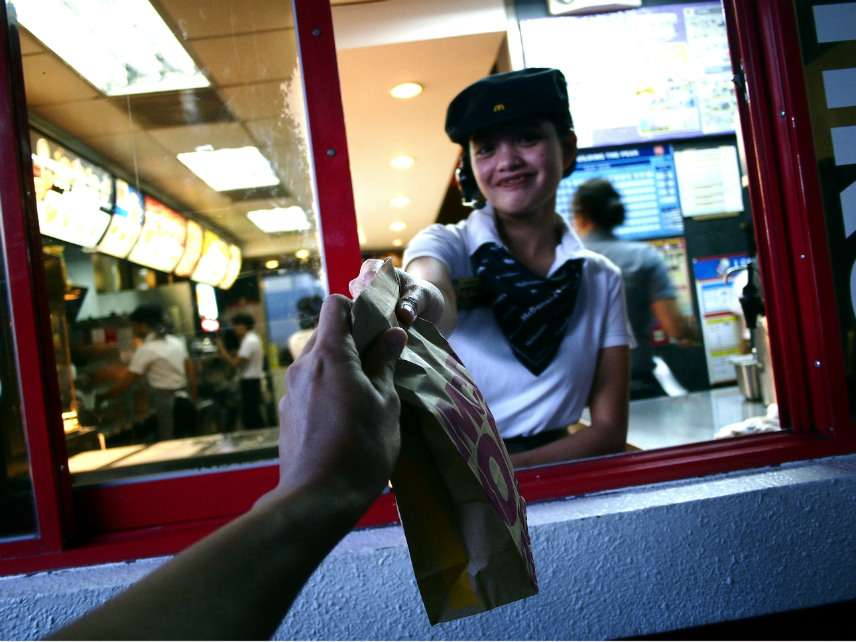Sacramento Wants to Boost Rail Ridership By Banning Drive-Throughs and Gas Stations Near Transit
The logic of the policy is perplexing.

Faced with falling ridership, American cities have been experimenting with increasingly desperate measures to get people back onto buses and trains.
New York, which saw subway ridership plunge by 30 million trips from 2016 to 2017, is cracking down on transit's competition, with politicians pondering a cap on the number of rideshare vehicles allowed in the city and a mandatory floor for Uber and Lyft prices. Los Angeles, where transit use is stubbornly stuck at about 5 percent of all trips, is spending billions to build out its light rail network and cluster more development around transit stops. Washington is investing in flashy marketing campaigns and a new merch shop to reverse its Metro system's near 20 percent decline in ridership since 2012.
But Sacramento has the most creative approach. Absurd, but creative. City staff there are drafting an ordinance that would ban building new gas stations, drive-throughs, and other auto-related businesses within a quarter mile of any of the city's 23 light rail stations. (Also to be prohibited, for reasons unclear: marijuana cultivation sites.) Other businesses "not considered transit-supportive"—car lots, auto repair businesses, manufacturing sites, wholesale outlets—would still be allowed, but only if the city grants them a special permit.
Preexisting businesses would be grandfathered in.
Though the plan is still in the early stages, the Sacramento Bee reports that it has already attracted support from some city councilmen and from the Sacramento Regional Transit (SacRT), which operates the city's buses and light rail network. "I'm encouraged that this will attract new riders," SacRT head Henry Li tells the Bee.
How exactly this is supposed to attract new riders is a bit of a mystery.
Would a motorist really decide to switch to transit if using a drive-through window is not an option, or would he instead just patronize a different fast-food joint that's further away from a light rail station? Would someone really leave her car at home because she can't gas up near a transit stop that she isn't using already?
If anything, this seems like it would further deter light rail by inconveniencing people whose commutes involve a mix of transit and driving. It's fair to assume that fewer people will use the 16 park-and-rides located at Sacramento's light rail stations if they can't get gas or food anywhere nearby.
The way city planners explain it, booting businesses that cater to motorists will open up room for new development that will better serve riders, thus boosting ridership.
"You wouldn't ride light rail to a gas station, but you would ride it to buy groceries, get a haircut or have a meal," city planner Jim McDonald tells the Bee.
Yet the businesses targeted by this ordinance can and do cater to both transit-takers and motorists alike. After all, restaurants with drive-through windows typically have dining rooms too. And plenty of gas stations make money selling not just low-margin gas but soda, snacks, and cigarettes.
Surely some businesses would think twice about locating near light rail if they knew that their access to customers who drive will be curtailed. Serving a transit-only crowd probably doesn't sound very enticing right now, given that the number of people using Sacramento's transit system has been spiraling downward for years. In 2017 alone, ridership declined by about 10 percent.
That reflects a larger trend. In fiscal year 2009, the city's two light rail lines serviced an average of 58,000 riders every weekday. By the end of fiscal year 2016, that number had fallen to about 44,600 weekday riders, even though the city had opened a whole new light rail line during that time. According to a study by the Cato Institute's Randal O'Toole, less than 3 percent of commutes are taken via transit in the Sacramento urban area.
Transportation works best when people can make real choices about what mode of travel works best for them, and when businesses can dynamically respond to those choices. Policy makers' role should be to facilitate these choices, not to try to reverse them—and especially not with a measure as hamfisted as this one.
Rent Free is a weekly newsletter from Christian Britschgi on urbanism and the fight for less regulation, more housing, more property rights, and more freedom in America's cities.


Show Comments (100)